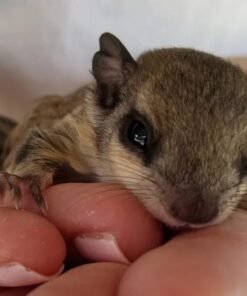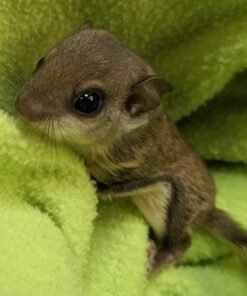Flying Squirrel
Flying Squirrel: Detailed Overview
Scientific Classification:
- Family: Sciuridae
- Subfamily: Pteromyinae
General Description
Flying squirrels are small to medium-sized nocturnal rodents known for their ability to glide through the air using a membrane called the patagium. They are found in a variety of habitats around the world, including North America, Europe, and Asia. Flying Squirrel
Physical Characteristics
- Size and Appearance
- Weight: Varies by species, typically ranging from 100 to 300 grams (3.5 to 10.6 ounces).
- Length: Body length ranges from 20 to 30 cm (8 to 12 inches), with a tail length of approximately 12 to 15 cm (5 to 6 inches).
- Fur: Soft and dense, usually gray, brown, or reddish, with lighter underbellies.
- Eyes: Large and prominent, adapted for nocturnal vision.
- Patagium: A skin membrane stretching from the wrist to the ankle, enabling them to glide. FEMALE FLYING SQUIRRELS FOR SALE
- Unique Adaptations
- Patagium: Allows them to glide distances of up to 150 feet or more.
- Tail: Used for stability and steering during glides.
Behavior and Lifestyle
- Activity Patterns
- Nocturnal: Active primarily at night, which helps them avoid many predators and forage for food under the cover of darkness.
- Social Structure
- Flying squirrels are generally social and may live in small groups, especially in colder climates where they huddle together for warmth.
- Communication
- Use a variety of vocalizations and chemical signals for communication.
- Their large eyes help them communicate visually in low light.
Habitat
- Range
- Found in deciduous and mixed forests, but some species also inhabit tropical rainforests and temperate coniferous forests.
- Nesting
- Nest in tree cavities, abandoned woodpecker holes, and nest boxes.
- Line their nests with soft materials like leaves, moss, and feathers.
Diet
- Primary Diet
- Omnivorous, eating a variety of foods including nuts, seeds, fruits, fungi, insects, and bird eggs. MALE FLYING SQUIRRELS FOR SALE
- They have a special fondness for tree sap and buds.
- Foraging Behavior
- Forage at night, using their keen sense of smell to locate food.
- They store food in their nests or in hidden caches for winter months.
Reproduction
- Breeding Season
- Breeding seasons vary by species and region, typically occurring twice a year.
- Gestation Period: About 40 days.
- Litter Size: Usually 2 to 4 young.
- Parental Care
- Mothers take care of the young, nursing them until they are old enough to start gliding and foraging on their own.
Conservation Status
- Threats
- Habitat loss due to deforestation and urban development.
- Predation by domestic cats and other predators.
- Conservation Efforts
- Preservation of forest habitats and installation of nest boxes to provide safe nesting sites.
Interesting Facts
- Gliding Ability
- Flying squirrels don’t actually fly; they glide. They launch themselves from a high point and spread their limbs to stretch the patagium, allowing them to glide gracefully through the air.
- Navigation Skills
- Remarkable ability to navigate through dense forests at night using their excellent night vision and spatial memory.
- Winter Behavior
- In colder climates, flying squirrels may enter a state of torpor to conserve energy, although they do not hibernate.
Conclusion
Flying squirrels are fascinating creatures known for their unique gliding ability, nocturnal lifestyle, and social behaviors. They play an important role in forest ecosystems, BUY FEMALE FLYING SQUIRRELS, helping with seed dispersal and providing prey for predators. Understanding their behavior, habitat needs, and conservation status is crucial for ensuring their continued survival in the wild.



